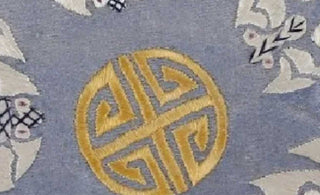
In the realm of art, few traditions possess the captivating allure and timeless elegance of traditional Oriental artistry. Rooted in centuries of cultural heritage, the art forms of ink painting and silk embroidery have enthralled audiences with their unique aesthetics, technical prowess, and profound symbolism. In this article, we embark on a journey to explore the enchanting world of ink and silk, delving into their historical significance, artistic techniques, and enduring relevance in contemporary art.
I. The Intertwined History of Ink Painting and Silk Embroidery
Ink painting, with its origins in ancient China, has become synonymous with the spirit of Oriental art. It represents a harmonious blend of nature, spirituality, and philosophical contemplation that permeates Eastern culture. By employing a minimalist approach, ink painting transcends the limitations of color and focuses on the expressive power of brushstrokes and the dynamic interplay of light and shadow. With each stroke, the artist captures the essence of the subject and invites viewers to immerse themselves in a world of emotions and subtle nuances.
Silk embroidery, on the other hand, embodies meticulous craftsmanship and delicate artistry. This ancient technique, dating back to the Han Dynasty, involves the intricate stitching of silk threads onto fabric. The result is a visual extravaganza of vibrant colors, intricate details, and exquisite designs. Silk embroidery serves as a visual language, conveying stories, myths, and cultural motifs through its rich tapestry. Each thread and stitch contributes to the overall composition, creating depth, texture, and a sense of movement. It is a testament to the patience, skill, and dedication of the artisans who weave together strands of silk to create captivating artworks.
Both ink painting and silk embroidery hold immense cultural significance and symbolism. Ink painting often portrays landscapes, flora, and fauna, reflecting the deep connection between humanity and the natural world. Mountains, rivers, and bamboo symbolize strength, resilience, and harmony, while plum blossoms and lotus flowers represent purity and enlightenment. Beyond the representation of nature, ink painting embodies philosophical and spiritual concepts, inviting viewers to contemplate the transient nature of existence and seek inner peace.
Silk embroidery, on the other hand, showcases a rich tapestry of mythical creatures, legendary heroes, and auspicious symbols. Dragons, phoenixes, and peonies symbolize power, prosperity, and good fortune, while the depiction of figures from folklore conveys cultural narratives and aspirations. Silk embroidery is a medium for storytelling, cultural preservation, and social commentary, capturing the essence of a culture and carrying it forward through generations.
II. The Artistic Techniques
Brushwork: The brush becomes an extension of the artist's spirit, with every stroke capturing the essence of the subject matter. Techniques such as "the bone method" and "the flying white" allow artists to achieve different effects, from bold and energetic to delicate and ethereal.
Ink and Wash: The mastery of ink and wash techniques lies in the delicate balance between ink density and water dilution. Artists control the flow and diffusion of ink, creating gradations of light and shadow, and imbuing their compositions with depth and rhythm.
Thread Selection: The choice of silk threads, with their lustrous sheen and vibrant colors, is crucial in silk embroidery. Different threads, such as flat silk, round silk, and twisted silk, offer varying textures and effects, adding dimension and richness to the artwork.
Stitching Techniques: Silk embroidery encompasses a wide array of stitching techniques, including satin stitch, split stitch, and seed stitch. Each stitch contributes to the overall texture, shading, and contouring of the design, resulting in a visually captivating and tactile masterpiece.
III. Symbolism and Cultural Significance
Nature: Ink painting often portrays landscapes, flora, and fauna, reflecting the deep connection between humanity and the natural world. Mountains, rivers, and bamboo symbolize strength, resilience, and harmony, while plum blossoms and lotus flowers represent purity and enlightenment.
Philosophy and Spirituality: Ink paintings often embody the philosophies of Taoism and Buddhism, encapsulating concepts of balance, impermanence, and the pursuit of inner peace. The empty spaces within the composition, known as "blank areas," provide room for contemplation and invite viewers to reflect on the transience of existence.
Mythology and Folklore: Silk embroidery showcases intricate depictions of mythical creatures, legendary heroes, and auspicious symbols. Dragons, phoenixes, and peonies symbolize power, prosperity, and good fortune, while the depiction of figures from folklore conveys cultural narratives and aspirations.
Narrative and Social Commentary: Silk embroidery often tells stories, historical events, and social commentaries. By depicting scenes from literature or capturing social issues, it serves as a medium for storytelling, cultural preservation, and expression.
IV. Contemporary Relevance and Innovation
Traditional Oriental artistry continues to thrive in contemporary times, with artists innovatively adapting their techniques to suit modern sensibilities. Ink painting and silk embroidery now coexist with digital technology, mixed media, and unconventional materials, resulting in captivating fusion artworks that bridge the gap between tradition and innovation.
The allure of traditional Oriental artistry has transcended borders, captivating art enthusiasts worldwide. Galleries, museums, and art institutions across the globe showcase exhibitions and events dedicated to promoting and celebrating these art forms, fostering cross-cultural dialogue and appreciation.
Conclusion
Ink painting and silk embroidery embody the essence of traditional Oriental artistry, captivating audiences with their profound symbolism, intricate techniques, and timeless beauty. Rooted in rich cultural heritage, these art forms continue to evolve and thrive in the contemporary world, inspiring artists to push boundaries and forge new paths of innovation. The enduring allure of ink and silk lies not only in their aesthetic appeal but also in their ability to convey stories, emotions, and cultural narratives that transcend time and place. As we unveil the beauty and significance of ink and silk,we are reminded of the deep-rooted connections between art, culture, and human expression. In embracing the legacy of ink and silk, we honor the artistic legacies of the past while embracing the boundless possibilities of the future. Let us continue to celebrate and explore the captivating world of traditional Oriental artistry, allowing it to inspire and enrich our lives in profound and transformative ways.
























